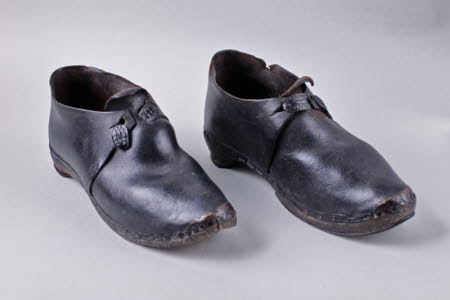Clog
Category
Costume
Date
1920
Materials
Leather, iron and beech wood
Order this imageCollection
Hill Top, Cumbria
NT 641936
Caption
‘Does Mistress Heelis really ever take her clogs off? I thought she went to bed in them?’ Mistress Heelis – better known as beloved children’s author and illustrator Beatrix Potter (1866–1943) – poked fun at her own attachment to her clogs in The Fairy Caravan (1929), an ode to the wild landscape and agricultural traditions of the Lake District. These sturdy leather clogs with thick wooden soles were worn by Potter as she carried out her daily business at Hill Top, the farmhouse she had purchased in 1905. After marrying local solicitor William Heelis (1871–1945) in 1913, Potter relocated from her parents’ home in Kensington to Castle Cottage in Near Sawrey, over the field from Hill Top. She was well known in the area for her eclectic taste in clothes, shunning respectable fashions and the expectations of London society in favour of simple practicality. The clogs were made by Charles William Brown of Hawkshead. Brown was employed as a bootmaker by the Hawkshead Cooperative Society on Main Street, opposite the offices of Potter’s husband, where Brown’s sister worked. Helen Antrobus
Summary
A pair of clogs with black leather uppers, irons and wooden soles, c. 1920, made by Charles William Brown of Hawkshead. They were worn by Beatrix Potter (1866–1943), c.1920 - 1943.
Full description
Beatrix Potter (1866 - 1943) wore clogs so frequently that she mocked herself in The Fairy Caravan (1929), with one of her collie dogs suggesting that she slept in them. Durable, reliable and hard-wearing when working and walking across her farms, this pair of clogs would have likely been worn by Potter between 1920 and 1943. The clogs were possibly made by Charles William Brown (1899 - 1976), a shoe and bootmaker based in Hawkshead with his family. Brown was employed by the Hawkshead Co-operative Society. His sister was a clerk at W.H Heelis & Sons - the family firm where William Heelis, Potter's husband, worked. Potter was photographed wearing a similar pair of clogs by the 1st Chorlton-cum-Hardy Guides in May 1929 (NT 242566).
Provenance
Previous owner had been given them by Capt. Duke in 1949.
References
Antrobus and Slocombe 2025: Helen Antrobus and Emma Slocombe, 100 Things to Wear: Fashion from the collections of the National Trust, National Trust 2025, pp. 158-159.
